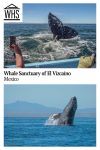Whale Sanctuary of El Vizcaíno
By Cindy Carlsson
What is the Whale Sanctuary of El Vizcaíno?
The Whale Sanctuary of El Vizcaíno World Heritage site includes two shallow lagoons (Laguna Ojo de Liebre and Laguna San Ignacio) and surrounding natural areas along the Pacific Coast of Mexico’s Baja California Sur. These lagoons are best known for the grey whales that travel here to breed and give birth each winter. However, this rich ecosystem also supports seals, sea lions, elephant seals, marine turtles, and hundreds of thousands of migrating birds.
Disclosure: This article contains affiliate links. Making a purchase through an affiliate link will mean a small commission for this website. This will not affect your price.
The Whale Sanctuary of El Vizcaíno World Heritage site is embedded in the far larger El Vizcaíno UNESCO Biosphere Reserve, which also protects inland ecosystems, wildlife, and a few cultural sites.
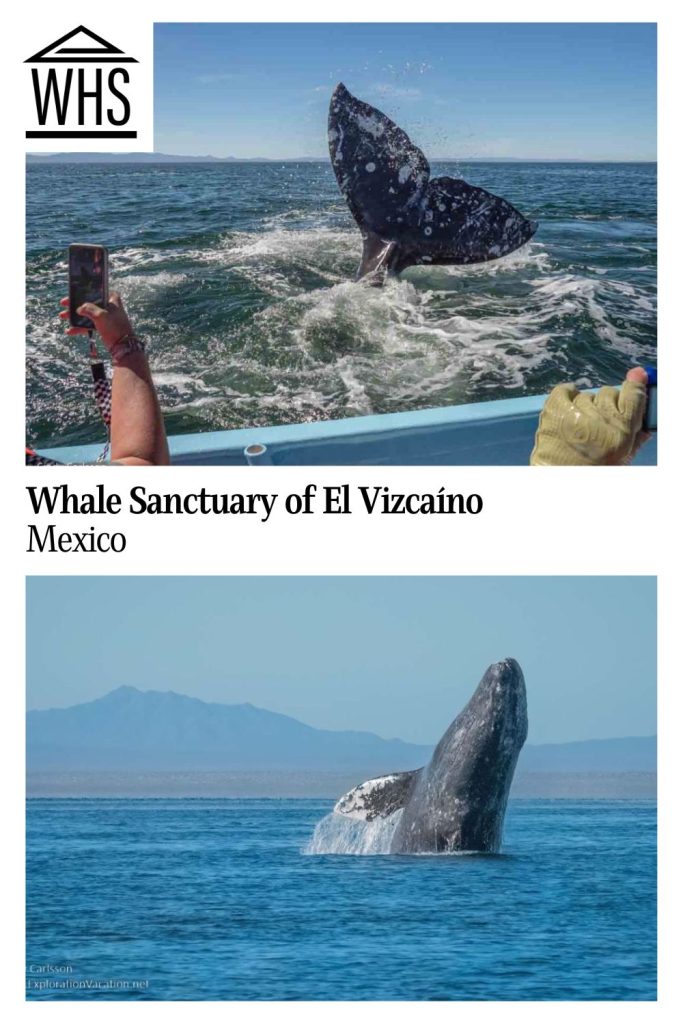
Why is the Whale Sanctuary of El Vizcaíno a UNESCO World Heritage site?
Although UNESCO recognizes the Whale Sanctuary of El Vizcaíno’s importance for supporting a variety of marine mammals, sea turtles, osprey, and migrating birds, the World Heritage designation focuses on the lagoon’s role in the survival of grey whales as a species.
As UNESCO explains: “The Whale Sanctuary of El Vizcaíno contains the most important breeding grounds of the Eastern subpopulation of the North Pacific Grey Whale. Its protection is intricately linked with saving the species from extinction and recovery after near-collapse due to excessive commercial whaling.”
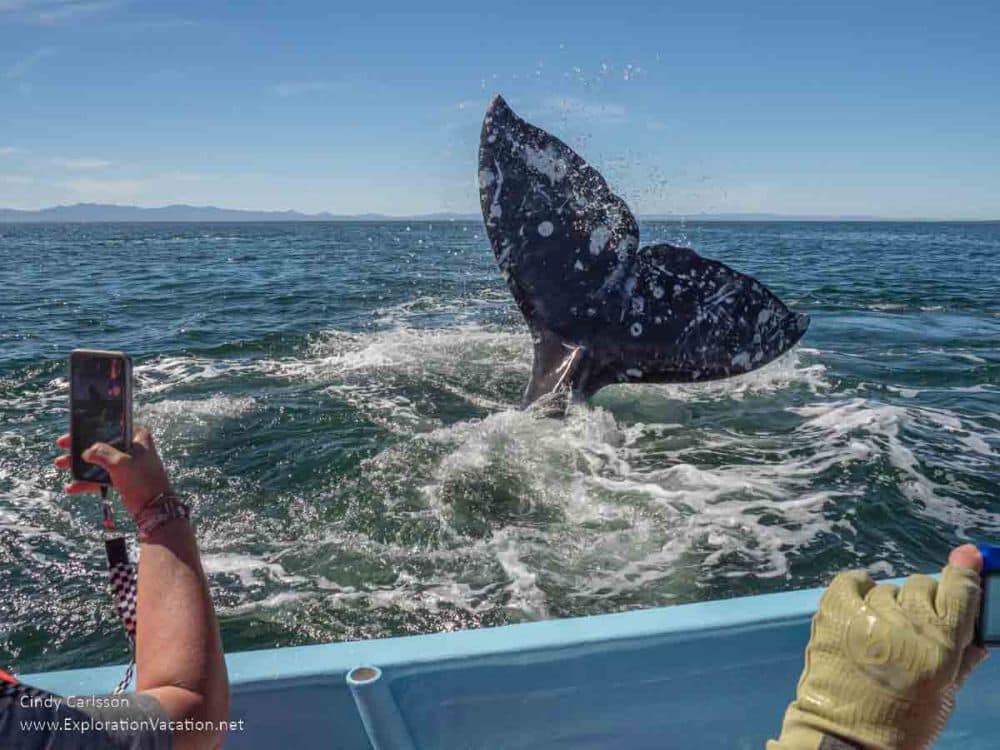
What can you expect on a visit to this whale sanctuary?
Like UNESCO itself, most visitors to the El Vizcaíno site are focused on the whales.
Grey whales spend their summers feeding in the Arctic before traveling up to 7,000 miles (over 11,000 km) to Baja for the winter. They begin arriving in El Vizcaíno by late December and leave to head north again by the end of April. While in Baja, pregnant females give birth, while other whales mate.
Visitors come here not only to see a high concentration of whales in one location (there may be hundreds or even thousands of whales in each lagoon during the winter), but to see them up close. The lagoons of the El Vizcaíno UNESCO site are two of only three places where these whales give birth. And, unlike anywhere else in the world, many will approach small whale-watching boats close enough to allow people to touch them and their newborn calves.
Whale watching is tightly regulated here, with limits on the number of boats and how close boats can get to the whales. However, the whales have no such limits and often come right up to boats. It’s not uncommon to have a number of whales swimming around, under, and alongside a boat. And many will poke their heads up right next to boats as if looking to be petted! Rub their heads and they seem to stay above water longer as if they enjoy the contact.
Needless to say, getting this close to a whale is an incredible experience.
You can also see mating activity. But you watch that from a bit of a distance, as it gets pretty frenzied.
The whale-watching experience is much the same in both lagoons within the El Vizcaíno site. Both are in rather isolated locations with limited services at the site itself. Both offer similar tours using small boats that are prohibited from following or approaching the whales. And neither allows access to nursery areas where grey whales actually give birth.
Of the two lagoons, Laguna Ojo de Liebre has many more whales than Laguna San Ignacio. But San Ignacio is smaller, so the whales are in a more confined area. It’s also where whales first started approaching boats and claims to have the “friendliest” whales.
The natural environment around the lagoons is harsh, but often beautiful and surprisingly full of life. Even if you spend most of your time whale watching, you’ll likely see a few dolphins, seals, coyotes, and lots of birds.
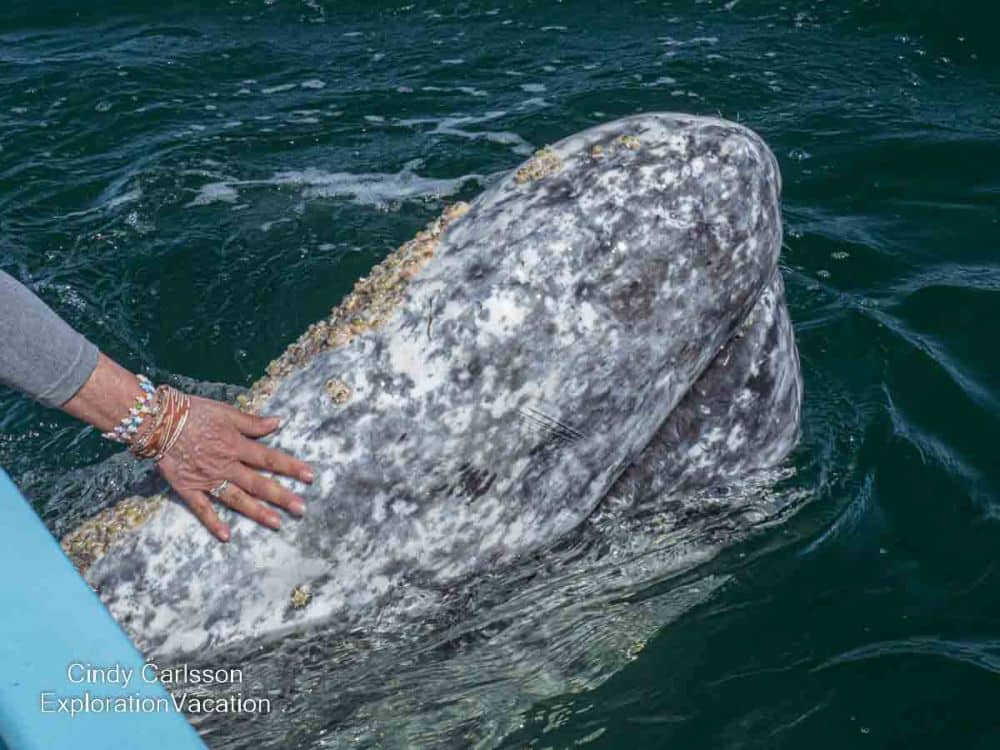
Is the Whale Sanctuary of El Vizcaíno worth visiting?
Want to see a whale up close (and maybe even touch one)? Then you need to plan a winter vacation to the Whale Sanctuary of El Vizcaíno. The whale watching here is unlike anything you will experience elsewhere. It is very much worth the time and expense it can take to get there.
(Whale watchers can also interact with grey whales and their calves outside the El Vizcaíno site at Magdalena Bay, which is a popular cruise stop. However, very few grey whales travel this far south and there are far fewer restrictions in place to protect the whales, making the El Vizcaíno site a much better place to see grey whales.)
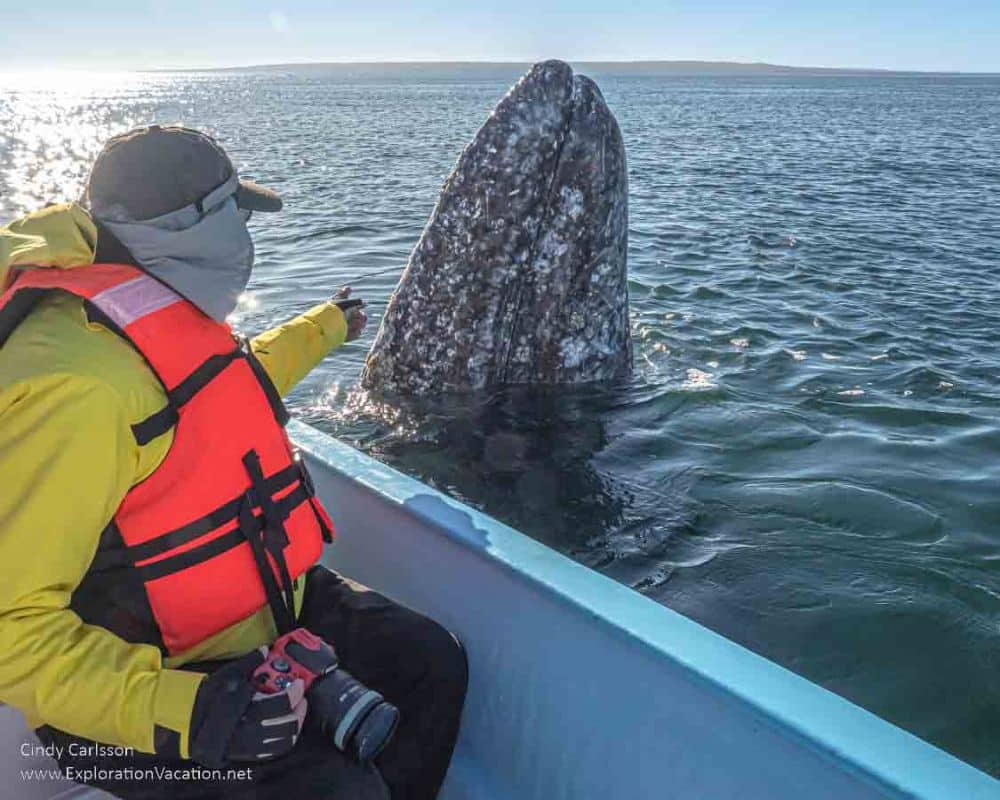
How much time do you need to visit El Vizcaíno World Heritage site?
How long it takes to visit the El Vizcaíno whale sanctuary depends on how lucky you are in timing your visit, how many times you want to go out to see the whales, and how many other things you want to do while at El Vizcaíno.
Whale watching tours include 90 minutes of whale watching, plus the time it takes to get out to the whales. At Laguna Ojo de Liebre (the larger of the two lagoons) you’ll need to allot at least 2-2½ hours each time you go out. If you are the first in line to get a boat on a still day in late February, you are likely to get out on the water, interact with some whales, and be back on shore in under three hours from the time you arrive at the lagoon.
This tour from La Paz goes to Laguna San Ignacio.
However, the number of whale-watching boats is strictly limited. And it can get too windy for boats to go out later in the day or at all. If you have to wait behind many others to get a boat or can’t go out at all because of the weather, it could take anywhere from a half day to several days just to get out on the water. And then, if you visit early or late in the season, you may have to go more than once before a whale comes up to your boat.
Because you will likely be going out of your way to get to El Vizcaíno, it’s best to plan at least a couple of days in the area even during peak whale-watching season. This increases your odds of actually getting close enough to touch the whales. And, if you are like most whale watchers who come here, you’ll want to go out and interact with these friendly whales more than once!
What sorts of travelers would like the Whale Sanctuary of El Vizcaíno?
Anyone who likes whale watching or is interested in wildlife in general will love seeing and interacting with the grey whales. (Think whale watching is boring? Seeing the whales in El Vizcaíno will change your mind!) This is a great adventure for families. And photographers will find much to love here – not just the whales, but many birds and a variety of fascinating landscapes.
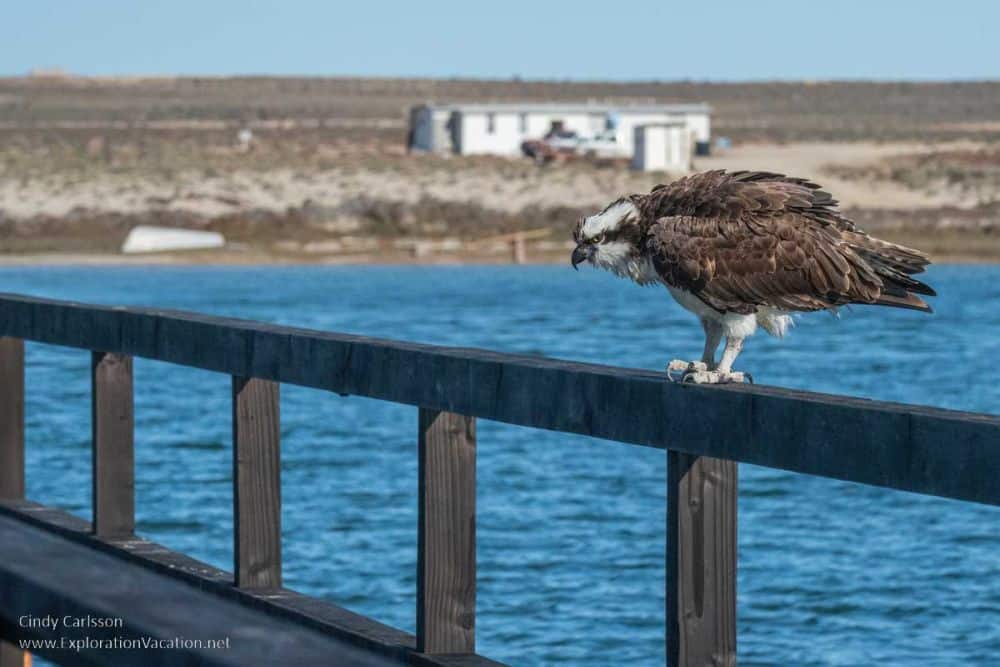
Tips for visiting the Whale Sanctuary of El Vizcaíno
Because whale watching is the predominant tourist draw at these lagoons, many tourism-based businesses close once the whales leave. There are still things to do off-season, but not as many.
Interacting with, let alone touching, wildlife is almost always dangerous for both humans and wildlife. But these grey whales seem to be the exception to the rule, as they only approach humans while in these lagoons and that contact appears to pose limited risks to them or their human visitors. Of course, scientists are actively studying this behavior to try to understand it and its impact on the whales.
Reserve a rental car here for your Baja road trip.
While both lagoons are easy to visit as part of a Baja road trip, logistics are more challenging if you don’t have a vehicle. Several whale camps at each lagoon offer full-service trips. These aren’t cheap, but offer an easy alternative if your time is limited or you aren’t ready for an independent driving tour of Baja.
This 6-day trip from San Diego, USA, visits both lagoons.
Camping and whale camps are the only lodging options along either lagoon. However, San Ignacio has more whale watching tours companies, docks, camps, and campgrounds along the lagoon than Ojo de Liebre.
Bring cash to pay for tours, food, and tips.
Tips for whale watching
Grey whales are only in these lagoons between late December and early April. The best time to see them mating is January and February. The best time to see newborn calves is February into March.
Go whale watching in the morning. Winds tend to strengthen during the day (especially at Laguna Ojo de Liebre), increasing the odds that boats won’t be allowed on the water later in the day. Besides, if you go out in the morning and winds stay calm, you can go whale watching two or even three times in a single day!
Dress in layers. Cold mornings quickly become hot. And don’t forget to bring sun protection.
Expect to get wet. You know how you spot whales at a distance by looking for spouts? Now those spouts will be right next to your boat – smaller ones may be right in your face. It’s just seawater, but your phone and camera might not handle it very well if they aren’t protected.
Never touch a whale’s fin or tail. They have incredibly strong muscles and a simple flip of a fin could leave you with broken bones.
Grey whales should be the only whales you see in these lagoons. They come here to give birth because the water is generally too shallow for orcas.
Take a look at other UNESCO sites in Mexico.
Other things to do while visiting El Vizcaíno
Bird watchers will find plenty to see within the World Heritage area during and between the fall and spring migrations. At Laguna Ojo de Liebre, the Refugio de Aves protects marshes that attract up to 95 species of migrating birds. Migration periods are best for birdwatching, but it’s easy to spot ospreys and many other birds throughout the winter.
Laguna San Ignacio is near the charming colonial town of San Ignacio. Located in an oasis filled with date palms, this tourist-friendly city has a beautiful historic mission and a variety of small tourist shops, restaurants, and lodging.
The whale sanctuary World Heritage site is inside the much larger El Vizcaíno Biosphere Reserve. The biosphere stretches across the peninsula, including lagoons, beaches, wetlands, marshes, and dunes along both coasts, as well as rugged mountains and other Sonoran Desert ecosystems. It’s a rugged area that is home to a range of wildlife including desert bighorn sheep, mountain lions, and a couple of types of very rare pronghorn antelope. Expect great roadside scenery, peaceful beaches (and a few beach resorts), epic hiking, cultural sites, and a few small towns.
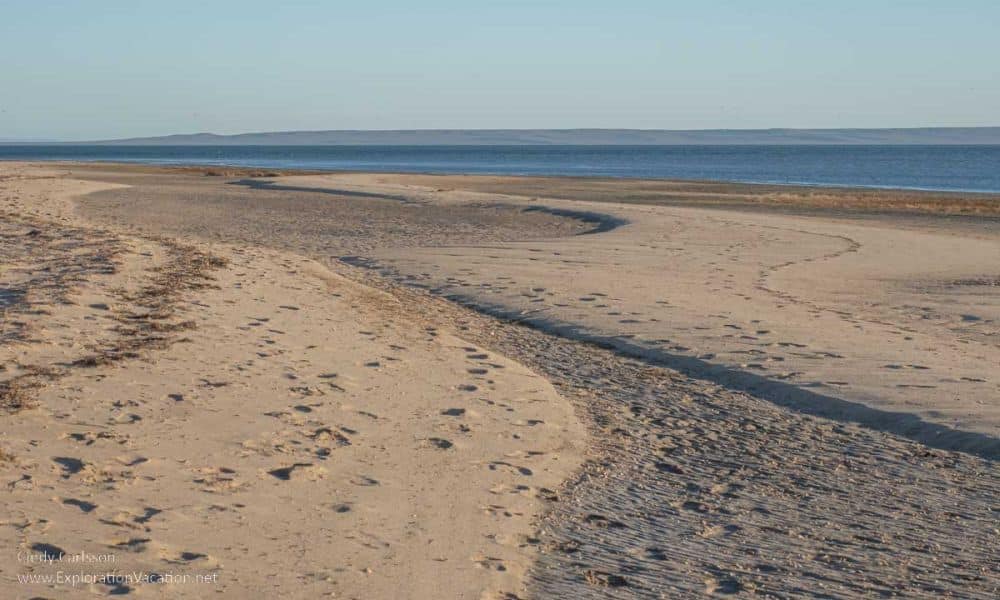
Cave paintings can be found inland, although most are more than a day trip from the El Vizcaíno whale sanctuary. Many of these, including most sites in the Sierra de San Francisco UNESCO World Heritage site, are only accessible as part of a multi-day guided hike.
Mexico’s Valle de los Cirios Flora and Fauna Protection Area is another nearby wilderness area. It includes some incredible-looking dunes located just north of Laguna Ojo de Liebre.
For something totally different, tour the world’s largest evaporative salt mine. It’s located right alongside the World Heritage area at Laguna Ojo de Liebre. So, even if you don’t take the tour, you’ll see plenty of surreal landscapes just driving near the lagoon.
Where is the Whale Sanctuary of El Vizcaíno?
Both lagoons in the whale sanctuary are in northern Baja California Sur, Mexico. That’s about half-way down the Baja Peninsula. This area is pretty remote, with very limited air service. Once you get to the gateway cities, you won’t find regularly scheduled public transportation to either lagoon. However, private transport is available for hire in both Guerrero Negro and San Ignacio.
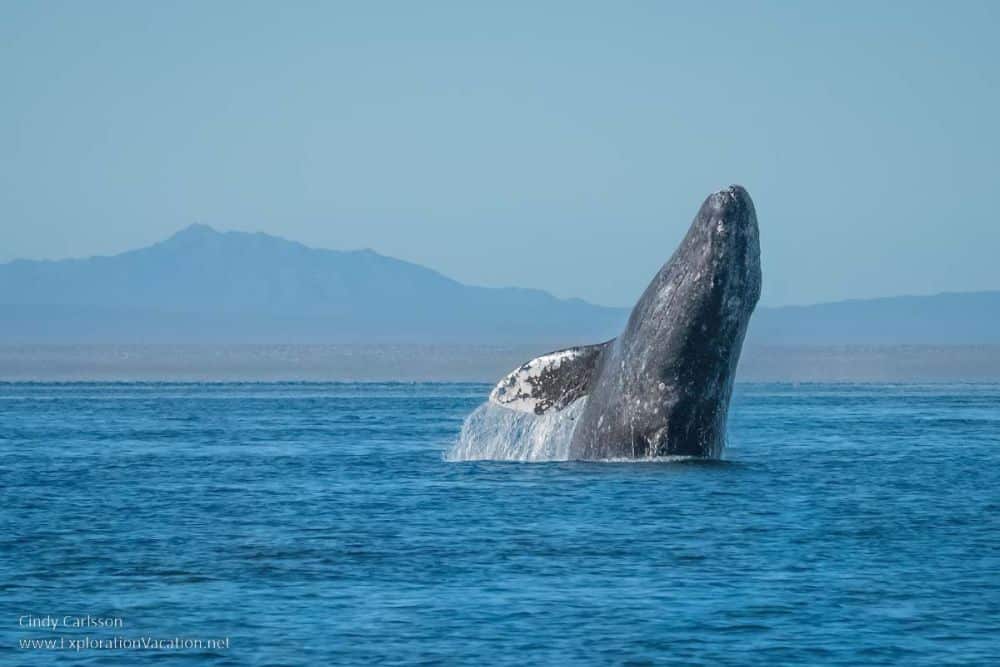
Getting to Laguna Ojo de Liebre
Laguna Ojo de Liebre (sometimes still referred to as Scammon’s Lagoon) is located south of the city of Guerrero Negro. Despite what Google says, it’s usually a good 12-hour drive from San Diego, California. But you can take Mexico Highway 1 all the way down, making it easy to access this area.
There are currently no direct flights into Guerrero Negro from the USA. However, you can fly there from other parts of Mexico, including Ensenada, which is just a few hours’ drive south of Tijuana.
Accommodations in Guerrero Negro.
Once in Guerrero Negro, the best docks are less than an hour further south on unpaved roads that can get rough. The main dock is marked on Google maps as Muelle Ojo de Liebre. It has some UNESCO displays and other information, as well as a restaurant, basic campground, and large parking area.
The map below is centered between the two lagoons of the UNESCO site and shows various options for accommodations, but not any campgrounds right on the lagoons. Plug in your travel dates to see what’s available.
Getting to Laguna San Ignacio
The town of San Ignacio is another a 2-hour drive southeast of Guerrero Negro on Highway 1. (The highway runs through the El Vizcaíno Biosphere and some of the scenery is stunning.)
There are airstrips both in town and near the lagoon, but they don’t seem to serve regularly scheduled commercial flights. You can fly into Loreto from the USA and drive to San Ignacio, but it’s at least a 4-hour drive. (Be careful when searching for flights or other transport into San Ignacio, as lots of cities have that name, including others in Baja Sur!) Once you get to San Ignacio it’s about a 1½-hour drive on a road that can get pretty rough to get to the lagoon’s southeastern shore. There you’ll find a long string of whale watching boat launches, tour companies, camps, and campgrounds along the edge of the lagoon.
For current information about Whale Sanctuary of El Vizcaíno UNESCO World Heritage Site, its opening hours and admission fees, check in at any of the docks or simply ask at your hotel or campground.
Have you been to the Whale Sanctuary of El Vizcaíno? If so, do you have any additional information or advice about this UNESCO World Heritage site? Please add your comments below!
Cindy says everything came together perfectly for her recent trip to the Whale Sanctuary of El Vizcaíno. She describes the experience as so incredible it was hard to believe it was real even while it was happening. And then it happened all over again the next day . . .

